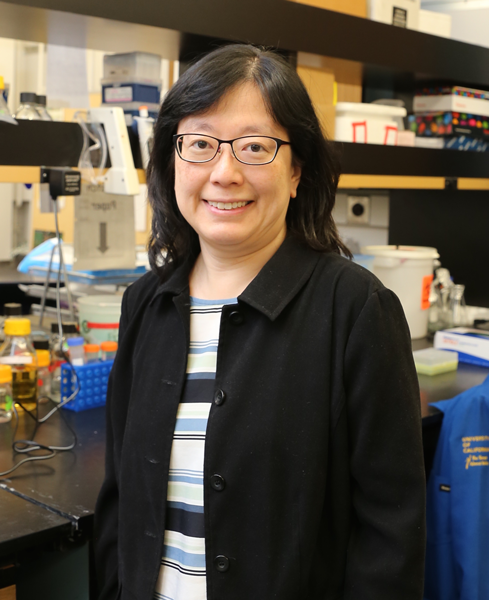Restyling Nature’s Designs
Wang and her team redesign protein nanoparticles that occur in nature to develop new applications.
Jan. 4, 2017 - Nature has a lot of experience and a pretty good reputation when it comes to assembling tiny nanometer-sized building blocks into viable organisms. Now, Samueli School researchers are taking a lesson from nature herself; using bio-inspired nanostructures, which they alter with chemistry or genetic manipulation, to develop innovative applications that could benefit human health.
The team, led by the Samueli School’s Szu-Wen Wang, professor of chemical engineering and materials science, is redesigning protein nanoparticles that occur normally in nature in order to deliver drugs to specific sites, create cancer-fighting vaccines and reengineer tissue, for starters.
The strategy is known as biomimetics, or biomimicry. Wang says the team’s efforts currently are focused on two aspects: creating hollow structures that can carry drug molecules inside them; and manipulating polymer chains to interact with cells in such a way that specific cells will respond to them while others will not.
“It all goes back to how the structures are made,” says Wang, who won the Samueli School’s Mid-Career Faculty Excellence in Research award last spring. “We look at how nature does this, how it creates them and what it uses them for. Then we try to take these fundamental structures and redesign them for a new purpose.”
Nature designs a hollow “Bucky ball”-type nanoparticle, for example, with multiple layers on its surface, each responsible for a different function. Wang’s team has genetically removed these outer layers and changed the surface properties so that a variety of molecules – either synthetic or biological – can attach and provide the structure with new properties. They also can chemically change the particle’s internal properties, allowing drugs or other molecules to be encapsulated within them.
What’s more, the team has learned how to open and close these nanoparticles by controlling how they assemble and disassemble. This could allow the particles to easily release the drugs they’re carrying when they arrive at their pre-determined destination.
Wang and her researchers, together with Dr. Edward Nelson's research group in the Department of Medicine, also are investigating whether biomimetics could help design more effective cancer vaccines. Studies over the last several years have shown elevated immune responses to experimental cancer vaccines, but they were nowhere near the level needed to eradicate the cancer.
Wang realized that proteins used in currently successful vaccines – for example those for flu – are similar in size and structure to the particles her team is working on. “We’ve repackaged our nanoparticles so they look like a virus to your body, but we put in cancer proteins instead,” Wang explains, adding that the design also includes foreign DNA that causes the body’s immune system to activate. They hope this will teach the body to respond to cancerous cells the way it does to cells infected with the flu virus.
Initial testing in mice has been positive. “When we put these cancer proteins in the nanoparticles and package them like they’re viruses, we obtain a much higher immune response against tumors,” she says, adding that they’ve experimented with several different types of cancer and the response has been similarly effective.
Wang’s team also is collaborating with ChEMS professor Nancy Da Silva on collagen – long, thin strands of polymers naturally produced by the body. They are manipulating the strands in order to modify the polymers’ interactions with cells, research that has applications in tissue engineering and stem cell differentiation (pushing stem cells to develop into specific cell types).
Wang is encouraged by the results of her team’s work. “When we first started, there were many different avenues that we explored,” she says, “but the biomedical research has really taken off. That’s been really exciting to me because you can see medical applications that can eventually help people."
--Anna Lynn Spitzer
